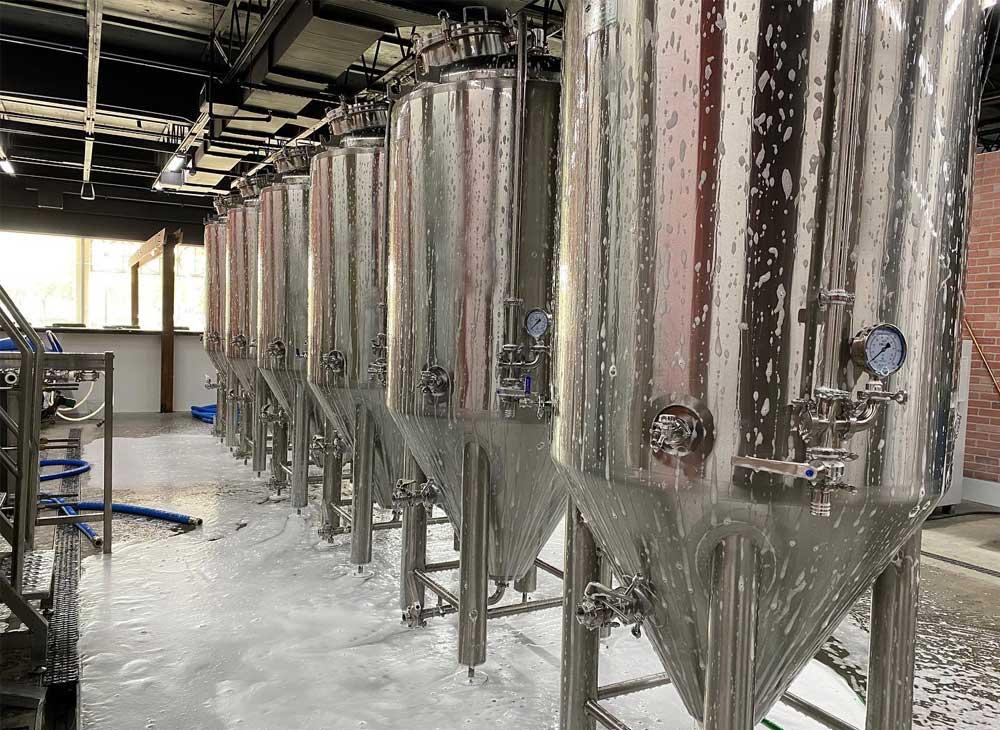
It is important to understand craft beer brewing equipment in order to become a competent master brewer. As well as being functional, safe and easy to operate, it is more important that good craft beer equipment is kept clean and hygienic. Limescale and microorganisms left inside the equipment can affect the taste and texture of the beer if it is not thoroughly cleaned and sanitized. Micro-organisms and dirt are the mortal enemies of every brewer. Cleaning beer brewing equipment is also an important task, so how should craft beer brewing equipment be cleaned?
Dirt is a generic term used to describe the build-up of organic and inorganic build-up. For beer and wine, the most common sources of 'dirt' are proteins and minerals. They come from grains, hops, fruit and water etc. When bacteria start to grow, they attach themselves to the plastic and form limescale, scum and biofilm. Fermentation tanks look very clean, but the interior is lined with invisible micro-organisms and bacteria.
The hygienic management of the equipment is a key aspect of the production process in beer facilities. When beer is contaminated, it can lead to poor taste and, in severe cases, sour and spoiled beer, resulting in economic losses. To ensure a good production environment, cleaning of the beer equipment is essential.
Before cleaning, the craft beer equipment to be cleaned must be turned off to prevent unnecessary accidents. The cleaning fluid must be in direct contact with the dirt. The concentration, temperature and time of the cleaning solution must be in accordance with the process requirements. The mechanical operation must be fully applied to the parts to be cleaned.
The cleaned dirt must be removed from the equipment in a fluid manner, i.e. it must be dissolved and freed from adhesion in order to prevent redeposition of dirt. All cleaned dirt must be completely removed from the system being cleaned.
The cleaning agent itself, which is harmful to the product, must also be completely removed from the system being cleaned. As a result of cleaning, the acid and alkaline concentrations are diluted and need to be adjusted and tested.
How to clean the pipes?
The locations of the pipes in craft beer brewing equipment are particularly prone to residual impurities. If these locations are not cleaned, even if the tanks are washed and cleaned, the brewed beer may deteriorate. To improve the cleaning effect, attention should be paid to the mechanical function of the pipes in the beer equipment when cleaning them. In order to receive better cleaning results, the flow rate in the pipes should be controlled at 1 to 1.5 metres per second when using hot cleaning liquids; when using cold cleaning liquids, different flow rates should be determined according to the diameter of the pipes. Rinse several times with hot water or alkaline water.
How to clean fermentation tanks?
The hygienic condition of the fermentation tanks has a great influence on the quality of the beer. Cleanliness and sterility are essential requirements for fermentation tanks. Rinse with water at room temperature; then prepare an alkaline solution of 2% to 4% and heat to 80-85°C for 30 minutes on a CIP cycle; rinse with water for another 5 to 10 minutes, then prepare a 1% to 2% solution of nitric or sulphuric acid for 30 minutes on a CIP cycle at room temperature; rinse with water for 5 to 10 minutes and prepare a 0.35% to 0.5% bactericide for 30 minutes at room temperature. Then rinse with sterile water to remove any residual bactericide. Smaller equipment such as 500L can be sterilised after a period of rinsing with boiling water. If the fermenter is particularly large, it is necessary to use a disinfectant such as hydrogen peroxide, peroxyacetic acid, no-rinse, etc. Disinfectants disinfect the fermentation tanks.
How to clean brewhouse equipment?
The cleaning of brewhouse equipment systems should remove as much dirt as possible from the tanks, pipes and equipment surfaces. However, some critical locations, such as the pipes behind the boiling tank or rotating water tank, as well as the pipes leading to the fermentation tanks, must be cleaned and rinsed several times with hot or lye water. Pre-rinse with water for 10 minutes at room temperature, then configure a 1%-2% sodium hydroxide solution and heat to 80-85°C for 30 minutes, followed by a CIP cycle of hot water at 90°C-95°C for 30-40 minutes to achieve cleaning.
Importance of cleaning beer equipment?
Metal surfaces that come into contact with materials during the production process can deposit some dirt for various reasons. Removal of yeast, protein coagulation, hop resin, oxalates, tartarates, carbonates and other organic and inorganic substances from tank walls and pipes prevents abiotic contamination in beer production; the purpose and role of sterilisation is to use suitable fungicides that can kill bacteria, fungi and other microorganisms and prevent biological contamination in beer production.
Still have a problem on choosing the brewery equipment? We can help with your final decision. If you are looking for a turnkey solution for craft beer brewing system, please contact us. We are looking forward to working with you. Send an email now: [email protected]


.jpg)





Get A Quote